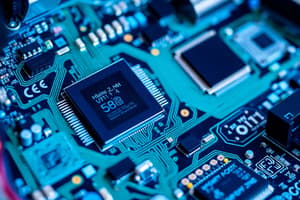Podcast
Questions and Answers
What is the primary function of the CPU in a computer?
What is the primary function of the CPU in a computer?
- Direct memory operations
- Interpret and execute commands (correct)
- Store data permanently
- Perform arithmetic and logic operations
Solid-State Drives (SSDs) are slower than Hard Disk Drives (HDDs).
Solid-State Drives (SSDs) are slower than Hard Disk Drives (HDDs).
False (B)
What does RAM stand for?
What does RAM stand for?
Random Access Memory
The __________ refers to the non-tangible part of a computer that tells it how to perform tasks.
The __________ refers to the non-tangible part of a computer that tells it how to perform tasks.
Match the following components with their functions:
Match the following components with their functions:
What was the primary purpose of the Antikythera Mechanism?
What was the primary purpose of the Antikythera Mechanism?
Charles Babbage completed a working model of the Analytical Engine.
Charles Babbage completed a working model of the Analytical Engine.
Who is credited as the world's first computer programmer?
Who is credited as the world's first computer programmer?
Leibniz's Step Reckoner introduced ______ arithmetic, which is a foundational concept for digital computing.
Leibniz's Step Reckoner introduced ______ arithmetic, which is a foundational concept for digital computing.
Match the following inventions with their inventors:
Match the following inventions with their inventors:
Flashcards
Antikythera Mechanism
Antikythera Mechanism
One of the earliest known analog computers, used to predict astronomical positions and eclipses.
Mechanical Era
Mechanical Era
Period (17th-19th centuries) marked by the development of mechanical calculating devices, leading to computer concepts.
Pascal's Calculator
Pascal's Calculator
Early mechanical calculator (1642) capable of addition and subtraction.
Leibniz's Step Reckoner
Leibniz's Step Reckoner
Signup and view all the flashcards
Analytical Engine
Analytical Engine
Signup and view all the flashcards
General-purpose computer
General-purpose computer
Signup and view all the flashcards
Punched cards
Punched cards
Signup and view all the flashcards
Ada Lovelace
Ada Lovelace
Signup and view all the flashcards
AI tasks
AI tasks
Signup and view all the flashcards
Quantum Computing
Quantum Computing
Signup and view all the flashcards
Hardware
Hardware
Signup and view all the flashcards
Software
Software
Signup and view all the flashcards
Liveware
Liveware
Signup and view all the flashcards
CPU
CPU
Signup and view all the flashcards
Control Unit (CU)
Control Unit (CU)
Signup and view all the flashcards
Arithmetic Logic Unit (ALU)
Arithmetic Logic Unit (ALU)
Signup and view all the flashcards
Registers
Registers
Signup and view all the flashcards
RAM
RAM
Signup and view all the flashcards
HDD
HDD
Signup and view all the flashcards
SSD
SSD
Signup and view all the flashcards
Study Notes
Introduction to Computing Sciences - Learning Outcomes
- Students will be able to explain basic computer and computing device components.
- Students will be able to describe various computer applications.
- Students will be able to explain information processing's role in society.
- Students will be able to describe the internet, its applications, and its impact.
- Students will be able to describe different computing specializations.
- Students will be able to demonstrate practical computer and internet skills.
Course Contents
- Brief computing history.
- Description of computer/computing device components.
- Input/output devices and peripherals.
- Hardware, software, and human ware.
- Computer/digital applications.
- Information processing and societal roles.
- The internet, applications, and impact.
- Computing discipline areas/programs.
- Computing professional job specializations.
- Future of computing.
Lab Work
- Practical demonstration of computer components.
- Illustration of various operating systems (desktops, laptops, tablets, etc.).
- Demonstration of common applications (word processors, spreadsheets, presentations).
- Illustration of input/output devices (printers, scanners, projectors).
- Practical internet and application demonstrations.
- Illustration of browsers/search engines.
- Online resource access demonstration.
Brief History of Computing
- Early Tools:
- Abacus (c. 2500 BCE): Earliest known calculation tool.
- Antikythera Mechanism (c. 100 BCE): Early analog computer predicting astronomical events.
- Mechanical Era (17th-19th Century):
- Pascal's Calculator (1642): Early mechanical calculator.
- Leibniz's Step Reckoner (1673): Improved Pascal's design to include multiplication and division.
- Analytical Engine (1837): First conceptual modern computer designed by Charles Babbage.
- Ada Lovelace: Credited with writing the first computer program.
Electromechanical Era (Early 20th Century)
- Zuse's Z3 (1941): First fully functional electromechanical computer.
- Harvard Mark I (1944): Large-scale electromechanical computer used in WWII.
Electronic Era (Mid-20th Century)
- ENIAC (1945): First general-purpose electronic digital computer.
- Transistor invention (1947): Revolutionized computer design by replacing bulky vacuum tubes.
Personal Computer Revolution (1970s-1980s)
- Apple I/II (1976/1977): Early commercially successful personal computers.
- IBM Personal Computer (1981): Standardized personal computing.
- Macintosh (1984): Introduced the graphical user interface (GUI).
Modern Era (Today)
- Smartphones: Increased computing power in mobile devices.
- Cloud computing: Remote data storage and processing.
- Artificial Intelligence (AI): Advancements in machine learning.
- Quantum computing: Potential to revolutionize computing.
Studying That Suits You
Use AI to generate personalized quizzes and flashcards to suit your learning preferences.
Related Documents
Description
This quiz focuses on the learning outcomes of an Introduction to Computing Sciences course. Students will be tested on their understanding of computer components, applications, and the societal role of information processing. Additionally, it will cover the internet's impact and various computing specializations.




